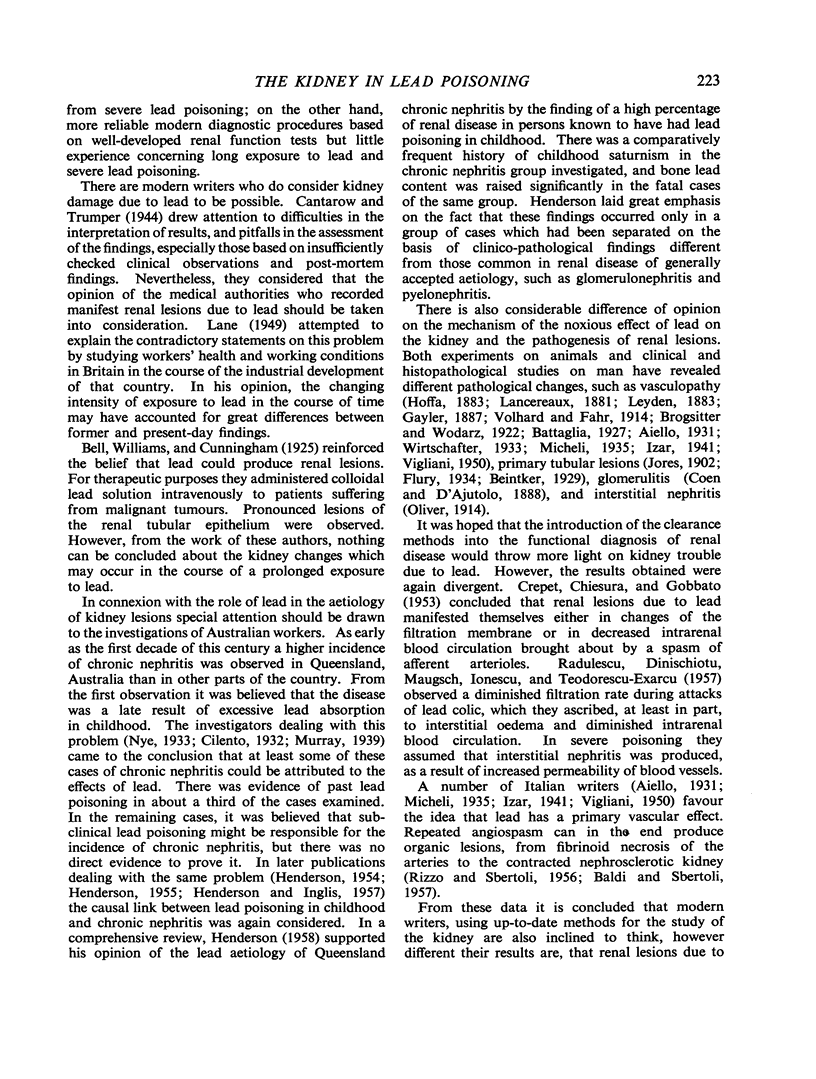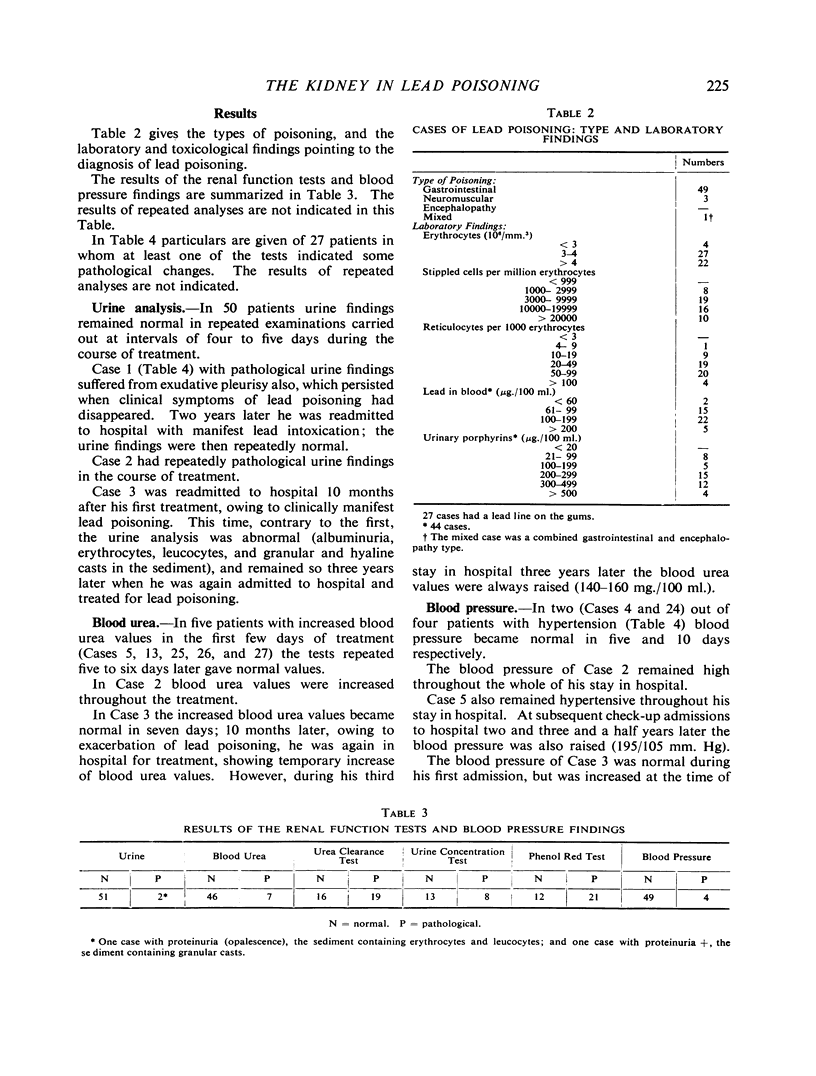Abstract
Kidney damage due to lead is still an interesting problem of industrial toxicology. In spite of abundant literature data, much still remains to be explained. There are controversial opinions, not only on the type of renal lesions due to lead, but also on whether lead affects the kidney at all.
In this paper our clinical observations on the effect of lead upon the kidney in 53 patients suffering from lead poisoning are presented. In 44 patients (40 men and four women) lead poisoning was due to occupation, and in nine (five men and four women) to the use of lead-glazed pottery. The length of exposure varied from two months to 35 years. In all cases the diagnosis of lead poisoning was made clinically and confirmed by laboratory tests.
Permanent changes in the form of chronic nephropathy were observed in only two patients. These were the two cases in which exposure to lead was the longest and most intense. Twenty-three patients showed functional renal lesions tending to normalize. In addition to the cases of organic nephropathy, blood pressure was persistently raised in one further patient; in two patients a raised blood pressure was observed only in the acute stage of poisoning.
On the basis of these findings we consider that lead intoxication can cause renal lesions. These lesions are for the most part functional and temporary. In cases of long and severe exposure and repeated lead intoxication, organic renal lesions seem possible. The disturbances of renal function observed in this study may be ascribed to disordered intrarenal circulation, due to the spastic effect of lead on intrarenal blood vessels, and to a direct toxic or indirect hypoxic effect of lead on the tubules.
When investigating renal function, we have observed that the timing of individual tests is of paramount importance. Some lesions are subject to changes in the natural course of lead poisoning, and unless this is borne in mind, apparently contradictory results may be obtained.
Full text
PDF








Selected References
These references are in PubMed. This may not be the complete list of references from this article.
- BALDI G., SBERTOLI C. Evoluzione delle alterazioni renali che possono condurre al rene grinzo saturnino: un caso dimostrativo. Med Lav. 1957 Oct;48(10):533–538. [PubMed] [Google Scholar]
- BERITIC T., DJURIC D. Intoksikacije olovom iz glazura zemijanog posuda. Hig Cas Hig Mikrobiol Epidemiol Sanit Teh. 1956;8(1):12–24. [PubMed] [Google Scholar]
- CLARKSON T. W., KENCH J. E. Urinary excretion of amino acids by men absorbing heavy metals. Biochem J. 1956 Mar;62(3):361–372. doi: 10.1042/bj0620361. [DOI] [PMC free article] [PubMed] [Google Scholar]
- CREPET M., CHIESURA P., GOBBATO F. Comportamento della funzione renale nella intossicazione professionale da piombo. Folia Med (Napoli) 1953 Mar;36(3):181–196. [PubMed] [Google Scholar]
- CREPET M., GOBBATO F. Alterazioni emodinamiche in corso di colica saturnina. Med Lav. 1954 Oct;45(10):523–532. [PubMed] [Google Scholar]
- GRANATI A., SCAVO D. Il comportamento dell'aminoaciduria nell'intossicazione professionale da piombo. Folia Med (Napoli) 1957 Oct;40(10):832–844. [PubMed] [Google Scholar]
- GREENFIELD I., GRAY I. The failure of lead poisoning to affect the heart and blood vessels. Am Heart J. 1950 Mar;39(3):430–435. doi: 10.1016/0002-8703(50)90342-5. [DOI] [PubMed] [Google Scholar]
- HADENGUE A., COLLIN M. Etudes sur le taux de l'azotémie des ouvriers exposés au plomb. Arch Mal Prof. 1951;12(5):561–565. [PubMed] [Google Scholar]
- HENDERSON D. A., INGLIS J. A. The lead content of bone in chronic Bright's disease. Australas Ann Med. 1957 May;6(2):145–154. doi: 10.1111/imj.1957.6.2.145. [DOI] [PubMed] [Google Scholar]
- MOELLER J., REX W. Nierenfunktionsstörungen bei tubulärer Insuffizienz. Z Klin Med. 1952;150(2):103–169. [PubMed] [Google Scholar]
- McIntosh J. F., Möller E., Van Slyke D. D. STUDIES OF UREA EXCRETION. III: The Influence of Body Size on Urea Output. J Clin Invest. 1928 Dec;6(3):467–483. doi: 10.1172/JCI100207. [DOI] [PMC free article] [PubMed] [Google Scholar]
- RADULESCU C., DINISCHIOTU G. T., MAUGSCH C., IONESCU C., TEODORESCU-EXARCU Recheches sur l'atteinte du rein dans le saturnisme industriel par l'étude du clearance de la créatinine et de l'urée. Arch Mal Prof. 1957 Mar-Apr;18(2):125–137. [PubMed] [Google Scholar]
- RIZZO A., SBERTOLI C. La diagnosi della nefropatia saturnina alla luce della moderna fisiopatologia renale. Med Lav. 1956 Feb;47(2):117–128. [PubMed] [Google Scholar]
- VIGLIANI E. C. Recenti studi sul saturnismo in Italia. Med Lav. 1950 Apr;41(4):105–123. [PubMed] [Google Scholar]
- WEBER K., RUZDIC I. Beitrag zur fiuorometrischen Bestimmung der Harnporphyrine. Experientia. 1951 Sep 15;7(9):354–355. doi: 10.1007/BF02166409. [DOI] [PubMed] [Google Scholar]


